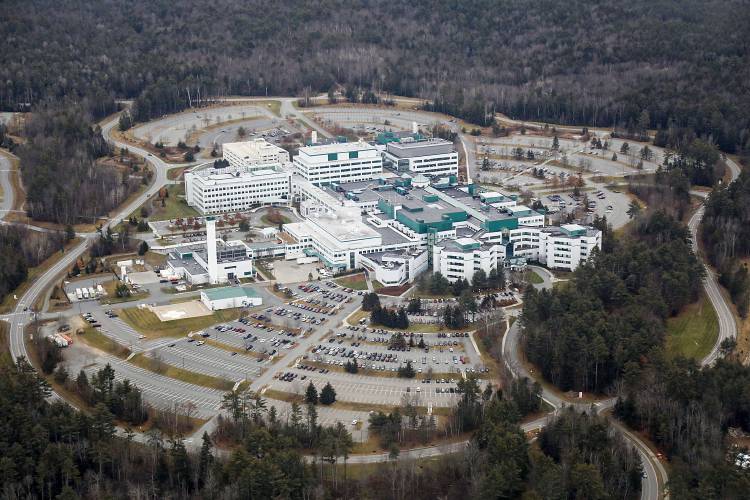Twin States see spike in pneumonia cases

Dartmouth-Hitchcock Medical Center in Lebanon, N.H., as seen from the air on Dec. 9, 2017. (Valley News - Charles Hatcher) Copyright Valley News. May not be reprinted or used online without permission. Send requests to permission@vnews.com. Charles Hatcher
| Published: 12-23-2024 6:31 PM |
WEST LEBANON — Two pneumonia-causing bacteria have been at especially high levels in Vermont and New Hampshire in recent weeks, leading to increased levels of illness.
At Dartmouth Hitchcock Medical Center, 97 patients with pneumonia went to the emergency room between September and November, compared to 46 during the same time last year, Dr. Michael Calderwood, chief quality officer at DHMC, said Friday. While final numbers aren’t yet available for December it “looks like the numbers may be improving.”
Pneumonia is an infection of the lungs often accompanied by fever, chills, cough, difficulty in breathing, fatigue and chest pain; it can be caused by multiple different viruses and bacteria, according to the Centers for Disease Control and Prevention.
The two types of potentially pneumonia-causing bacteria recently circulating in the region are: bordetella pertussis which causes whooping cough, a contagious respiratory infection that usually includes a severe cough and can lead to pneumonia, and mycoplasma pneumoniae, which causes walking pneumonia, a more mild form of illness that often does not require bed rest or hospitalization, Calderwood said.
Beyond DHMC, pneumonia-related emergency department visits also have been increasing across New Hampshire since mid-August and current levels are higher than this time in previous years, Madison Miller, a spokesperson for the state’s Department of Health and Human Services, said in an email.
Vermont also has seen a recent rise of respiratory illness outbreaks in schools believed to be specifically caused by mycoplasma pneumoniae, or walking pneumonia, Laura Ann Nicolai, deputy state epidemiologist and senior infectious disease program manager for Vermont, said in a Friday email statement.
Some children were specifically diagnosed with this kind of infection, but not all were tested for a specific pathogen by doctors.
The mycoplasma pneumoniae does not always cause pneumonia and often manifests as a chest cold. It mostly infects school-aged children, according to the Centers for Disease Control and Prevention, which has reported high levels of this bacteria nationwide.
Article continues after...
Yesterday's Most Read Articles
 Tree-clearing work near power lines causes Upper Valley outage
Tree-clearing work near power lines causes Upper Valley outage
 Lebanon to close street, block parking to allow outdoor dining
Lebanon to close street, block parking to allow outdoor dining
 Grantham superintendent resigning to become EMT amid rising political attacks on schools
Grantham superintendent resigning to become EMT amid rising political attacks on schools
 Residents disappointed Canaan’s Goose Pond won’t be full in time for summer
Residents disappointed Canaan’s Goose Pond won’t be full in time for summer
 Fairlee Drive-in won’t open for season this summer
Fairlee Drive-in won’t open for season this summer
Statewide, the Vermont Department of Health has received seven reports from school nurses of these respiratory illness outbreaks, ranging in size from five to 31 cases. One such outbreak occurred in a Windsor County school, Nicolai said.
The Department of Health issued a health advisory to providers and school nurses Nov. 22 warning them of increased pneumonia cases. Many of the cases are suspected to be caused by mycoplasma pneumoniae and providers should consider that patients may be infected with this bacteria, treat them accordingly and report “any unexpected pattern or cluster of illness” to the state, the advisory said.
The number of cases of pneumonia, flu and “other cold viruses” overall at Gifford Health Care’s primary care clinics and emergency department has been mostly typical over the past few months, though the number of children infected is higher than usual, Gifford spokesperson Ashley Lincoln said.
Doctors attribute the rise to “fewer kids getting vaccinated.”
Nationally, children born since the COVID-19 pandemic, between 2020 and 2021, were less likely to have received standard vaccinations that children get before turning 2, with one of the lowest rates being the pneumococcal vaccine that is recommended for children under 5, according to a September CDC study.
This vaccine covers the most common type of pneumonia, pneumococcal; it does not prevent walking pneumonia, for which there is no vaccine.
The pneumococcal vaccine is recommended for children under 5, adults over 50 and people at higher risk of respiratory illness. Whooping cough is prevented by the DTaP and Tdap vaccines that are recommended at different frequencies depending on a person’s age.
Pneumonia can also occur as a secondary infection after someone has had another respiratory illness such as a cold, the flu, COVID-19 or RSV, according to the American Lung Association.
Vaccinations against COVID-19, the flu and RSV can help protect against pneumonia, according to the CDC.
Some additional ways people can minimize the spread of disease include: washing hands, staying home when sick and “donning a mask in public if they are concerned about their own and others’ health,” Calderwood said.
Clare Shanahan can be reached at cshanahan@vnews.com or 603-727-3216.






 Dartmouth doctoral student back on campus after visa status was thrown into doubt
Dartmouth doctoral student back on campus after visa status was thrown into doubt
